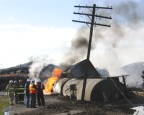
DOT Rule Requires Stronger Railroad Hazmat Tank Cars
In a move intended to enhance safety on the nation's railroads, U.S. Transportation Secretary Mary E. Peters announced a final rule yesterday to improve the crashworthiness of railroad tank cars used to transport some of the most dangerous hazardous materials.
"Strengthening rail hazmat tank cars will reduce the risk of spills and increase public safety should a train accident occur," Peters said, noting the final rule is focused on poison inhalation hazard (PIH) materials like chlorine and anhydrous ammonia heavily used in water treatment, agricultural, and industrial applications.
The final rule requires PIH tank cars to have better puncture resistance from a side impact with a combination of thicker inner shells where the hazmat is held and/or thicker outer jackets depending on the specific hazmat being transported.
In addition, each end of the tank car is to be protected with a full head shield where not already mandated by existing regulations and strengthened valves, top fittings, and nozzles used to load and unload the tank car are required to prevent a release in a rollover accident.
The rule also imposes a 50 mph maximum speed restriction on all loaded PIH tank cars and allows for an increase in the gross weight of the tank car to accommodate the enhanced safety measures. Also, it requires tank car owners to prioritize the retirement or replacement of older tank cars used in PIH service which were built prior to 1989 with non-normalized steel that may not adequately resist the development of fractures.
Peters added the final rule provides an increase in safety over existing rail hazmat tank car designs pending further technological and manufacturing advancements. Adoption of these interim design standards will ensure the ongoing availability of PIH tank cars with improved safety while DOT completes longer-term research, testing, and validation of advanced tank car designs for a more stringent performance-based standard to further increase rail hazmat tank car crashworthiness.
The final rule was issued by DOT's Pipeline and Hazardous Materials Safety Administration in close consultation with the Federal Railroad Administration following a broad and multi-faceted review of virtually all aspects of rail tank car safety. It applies to PIH tank cars built on or after March 16, 2009.